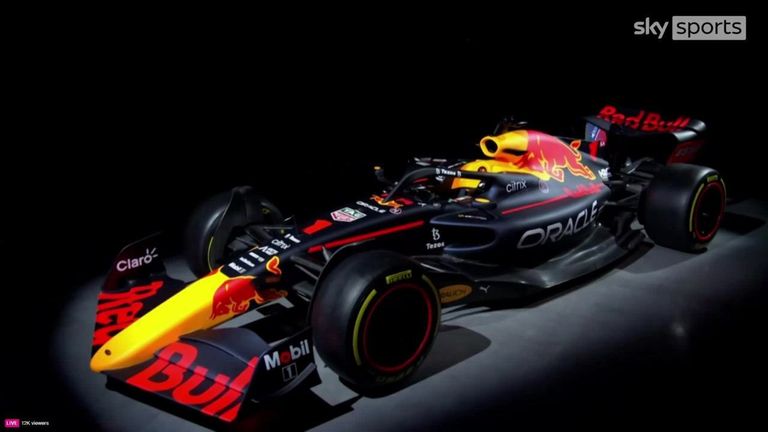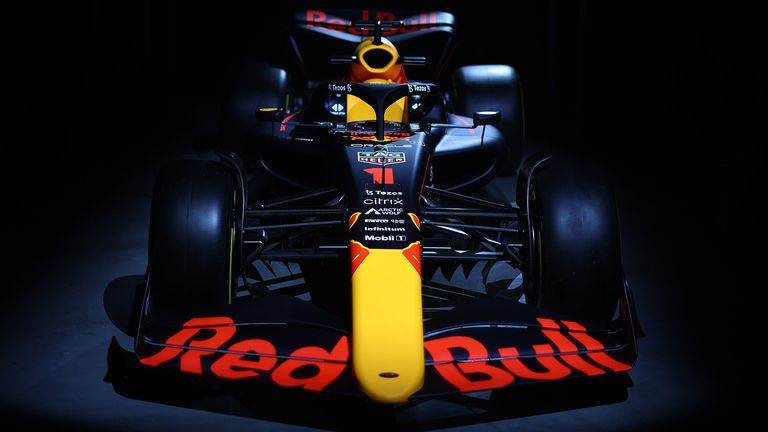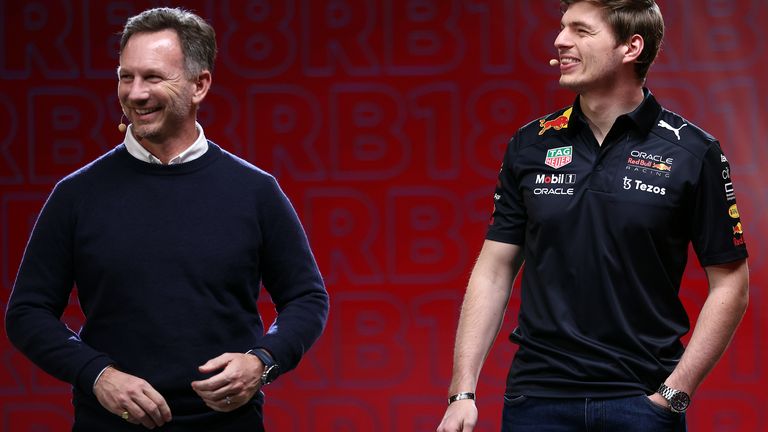Red Bull reveal new car and title sponsor as team launch RB18, Max Verstappen's next title hopeful
Red Bull launch the second car of F1 2022, with Max Verstappen, Sergio Perez and Christian Horner all at RB18 unveiling; new car built to F1's revolutionary new rules; team also confirm new title sponsor, with Oracle deal thought to be worth £100m a year over five seasons
Thursday 10 February 2022 11:20, UK
Red Bull have revealed their new car and new team name for 2022 as they look to remain at Formula 1's summit, with Max Verstappen bidding to retain his crown in the first year of the sport's all-new era.
The new RB18, while sporting the normal Red Bull livery, is another dramatic departure from the look of 2021, built to the sport's sweeping new rules as F1 bids to improve wheel-to-wheel racing.
F1's new drivers' champion Verstappen, as well as team-mate Sergio Perez and team boss Christian Horner, were all present at the launch, where Red Bull also confirmed a new title sponsor in American tech firm Oracle.
The team will now be known as Oracle Red Bull Racing, and Sky Sports understands the deal is one of the biggest in F1 history, worth £100m a year over five seasons.
The car is the second to be unveiled this year after Haas but Red Bull provided a first look at a 2022 machine in the flesh. Horner did, however, stress: "By the time we get to the first race the car will not look very much like this.
"And I think the evolution will be very quick as we progress through the season."
Will Red Bull, Verstappen build on 2021 glory?
Their new challenger certainly has a lot to live up to.
Last year, a resurgent Red Bull were title challengers for the first time since their four straight championships from 2010 to 2013.
While they were pipped in the team standings by F1's next dominant force Mercedes, the sport does have a new drivers' champion in Verstappen, who edged out Lewis Hamilton in a thrilling, yet hugely-controversial, decider.
Verstappen will be sporting the No 1 on his car this year - he is the first title-winner to elect for that privilege since Red Bull's previous champion, Sebastian Vettel in 2014.
"We're aiming to build on what we achieved last year, which is to retain the title," said Horner.
"The big unknown is have we missed something in these regulations, has another team stolen a march because they've focused on it since 2021?
"We believe we've got a good car. The RB18 is coming alive."
It is not just a new era for F1 this year, but also Red Bull due to their new title sponsor and the fact their previous engine suppliers Honda have left the sport.
After a new agreement, Red Bull are using the same Power Units as before while, looking to the long-term future, the team have set up their own powertrains division to build engines themselves.
F1's new rules have been introduced in a bid to improve racing but also competitiveness, meaning the likes of Red Bull and rivals Mercedes will likely be looking over their shoulders come the start of a new season as, with a fresh slate, more teams have been given a better chance of racing at the front.
But Red Bull evidently believe they can fight for, and win, an F1 title again.
"A lot is unknown about the car," said Verstappen.
"What is important is to prepare yourself in the best way possible physically, but in terms of the car you don't know. I am very curious to see how the car goes on track."
The first pre-season test begins on February 23-25, while the first race of the season is on March 20 in Bahrain.
What are the changes for F1 2022?
The rule changes, which have been long in the making and were initially planned for 2021 before being delayed due to the coronavirus pandemic, mean we have a completely new generation of cars.
The concept is, in essence, a simplified yet striking new-look race car following a drastic aerodynamics overhaul.
The key changes are:
- A ground-effect floor. The 2022 car has two long underfloor tunnels which create a 'ground effect' - meaning there is more suction under the car to pull it to the tarmac, while also ensuring more of the downforce is generated from under the car. The concept was popular back in the 1970s and '80s in F1.
- A simplified front wing and a sharp new rear wing. These not only look great, but the completely new parts on the 2022 cars have been designed to stop sending airflow outwards, narrowing it instead. The curved rear wing still has DRS, although it may be less impactful.
- 18-inch tyres with wheel winglets. Another throwback addition, the bigger tyres are aesthetically pleasing while they should also improve the handling of the cars. The winglets have been added to help direct air away from the rear wing.
What will the changes do?
The new cars do not just look a lot different, but they should have a marked effect on the on-track product, with more exciting and competitive wheel-to-wheel racing the expectation.
They are designed with a focus on shifting the aerodynamic focus from the wings to underneath the car, making it easier to follow the car in front, and thus improve racing.
F1's estimations are that the 2021 cars lost 35 per cent of their downforce within three car lengths of the car in front and almost 50 per cent in a single car length. You may have heard the words 'dirty air'.
The new cars? They claim to drop those numbers to just four and 18 per cent respectively.
"They're relying a lot more on air passing underneath the car very quickly which sucks the car down onto the ground, and gives what we like to call ground effect," said Sky F1's Ted Kravitz.
"You've created a vacuum," added Anthony Davidson. "There's suction to the ground, and you're relying less on the wings to give you rear grip, and more on the floor."






